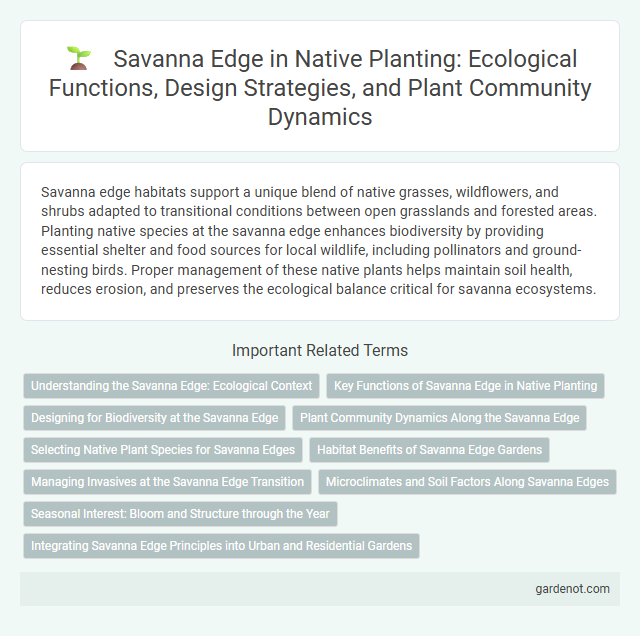Savanna edge habitats support a unique blend of native grasses, wildflowers, and shrubs adapted to transitional conditions between open grasslands and forested areas. Planting native species at the savanna edge enhances biodiversity by providing essential shelter and food sources for local wildlife, including pollinators and ground-nesting birds. Proper management of these native plants helps maintain soil health, reduces erosion, and preserves the ecological balance critical for savanna ecosystems.
Understanding the Savanna Edge: Ecological Context
The savanna edge represents a dynamic transition zone where grasslands meet woodlands, characterized by unique biodiversity and complex ecological interactions. This ecotone supports diverse flora and fauna adapted to fluctuating conditions of light, soil moisture, and fire regimes. Understanding these factors is crucial for native planting strategies that enhance habitat resilience and promote ecological balance.
Key Functions of Savanna Edge in Native Planting
Savanna edge plays a crucial role in native planting by serving as a transitional zone that supports diverse wildlife habitats and promotes biodiversity. This ecotone facilitates nutrient cycling and soil stabilization, enhancing ecosystem resilience. Incorporating native species at the savanna edge aids in maintaining pollinator corridors and natural pest control, crucial for sustainable landscape management.
Designing for Biodiversity at the Savanna Edge
Designing for biodiversity at the savanna edge prioritizes the integration of native plant species that support local wildlife and promote ecosystem resilience. Incorporating a diverse mix of grasses, shrubs, and flowering plants enhances habitat complexity, supporting pollinators, birds, and small mammals. Strategic planting along ecotones facilitates natural transitions, increasing species richness and ecological connectivity in these critical buffer zones.
Plant Community Dynamics Along the Savanna Edge
Plant community dynamics along the savanna edge exhibit a complex interplay of fire frequency, soil moisture gradients, and species competition, which shape vegetation structure and biodiversity. Grasses and forbs dominate the savanna interior, while woody species increase in density toward the woodland boundary, creating sharp ecotones with distinct microhabitats. These transitional zones are critical for native planting strategies aimed at restoring resilience and supporting diverse pollinator and wildlife communities.
Selecting Native Plant Species for Savanna Edges
Selecting native plant species for savanna edges involves prioritizing drought-tolerant grasses and wildflowers such as little bluestem, black-eyed Susan, and purple coneflower to enhance biodiversity and soil stability. Emphasizing deep-rooted species like prairie dropseed and switchgrass supports nutrient cycling and erosion control along transitional zones. Native shrubs like hazelnut and chokecherry provide essential habitat and food sources for pollinators and wildlife in savanna edge ecosystems.
Habitat Benefits of Savanna Edge Gardens
Savanna edge gardens create critical transitional habitats that support diverse wildlife, including pollinators, birds, and small mammals. These gardens enhance biodiversity by providing native plant species that offer food, shelter, and breeding grounds in fragmented landscapes. Integrating Savanna edge vegetation promotes ecological resilience and sustains local ecosystems through natural nutrient cycling and soil stabilization.
Managing Invasives at the Savanna Edge Transition
Managing invasives at the savanna edge transition involves targeted removal of aggressive non-native species to preserve native plant diversity and ecosystem function. Employing techniques such as selective herbicide application, controlled burns, and manual removal helps maintain the delicate balance between woodland and prairie species. Continuous monitoring and adaptive management are critical to prevent invasive species from outcompeting native plants and disrupting habitat integrity.
Microclimates and Soil Factors Along Savanna Edges
Savanna edges create unique microclimates characterized by increased sunlight exposure, wind patterns, and temperature fluctuations that influence native plant growth. Soil factors such as nutrient availability, moisture retention, and texture vary significantly along these transitional zones, affecting root development and species composition. Understanding microclimate variations and soil heterogeneity at savanna edges is crucial for successful native planting and ecosystem restoration.
Seasonal Interest: Bloom and Structure through the Year
Savanna edge native planting features a dynamic seasonal interest with vibrant blooms in spring and summer, including species like purple coneflowers and prairie blazing stars that attract pollinators. Structural elements such as tall grasses like little bluestem and switchgrass provide texture and movement throughout fall and winter months, maintaining visual appeal and habitat value. This combination ensures year-round ecological benefits and aesthetic diversity in native landscapes.
Integrating Savanna Edge Principles into Urban and Residential Gardens
Integrating savanna edge principles into urban and residential gardens enhances biodiversity by incorporating native grasses, wildflowers, and scattered shrubs that mimic natural savanna transitions. Promoting deep-rooted plants improves soil health and water retention, while maintaining open canopy structures supports pollinators and bird species adapted to savanna ecosystems. Designing with these elements creates resilient green spaces that sustain local wildlife and reduce maintenance through adaptive, drought-tolerant landscaping.
Savanna edge Infographic

 gardenot.com
gardenot.com